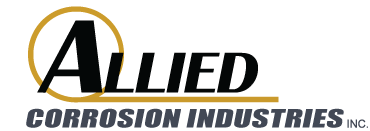1550 Cobb Industrial Dr. | P.O. Box 9098 | Marietta, GA 30065-2098
770-425-1355 (Phone) | 770-425-1354 (Fax) | info@alliedcorrosion.com (Email)
©2018 Allied Corrosion. All rights Reserved.
Made with ❤ by Mighty Good Marketing
Selected:
Single Pipe Roll includes two adjustable sockets and one roll axle.
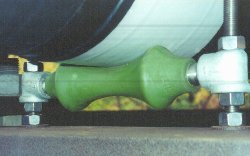
Single Pipe Roll includes two adjustable sockets and one roll axle.
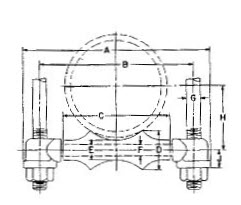
| Pipe Size | Rod Size | Adj. Socket Number |
Max. Load lbs. |
Weight lbs. each |
A | B* | C | D | E | F | H | J |
|---|---|---|---|---|---|---|---|---|---|---|---|---|
| 2 | 3/8 | #1 – 3/8 | 600 | 0.57 | 5 1/4 | 4 1/8 | 2 5/8 | 1 3/16 | 3/4 | 3/8 | 1 5/8 | 9/16 |
| 3 | 1/2 | #2 – 1/2 | 700 | 1.1 | 6 7/8 | 5 1/2 | 3 3/4 | 1 7/16 | 7/8 | 1/2 | 2 1/4 | 11/16 |
| 4 | 5/8 | #3 – 1/2 | 750 | 1.7 | 8 1/4 | 6 3/4 | 4 3/4 | 1 3/4 | 1 | 1/2 | 2 13/16 | 3/4 |
| 5 | 5/8 | #3 – 5/8 | 750 | 2.6 | 9 11/16 | 8 1/16 | 5 13/16 | 2 | 1 1/8 | 5/8 | 3 7/16 | 7/8 |
| 6 | 3/4 | #4 – 3/4 | 1070 | 4.5 | 11 7/16 | 9 9/16 | 6 7/8 | 2 5/16 | 1 1/4 | 3/4 | 4 | 1 |
| 8 | 7/8 | #5 – 7/8 | 1350 | 7.2 | 14 1/16 | 11 15/16 | 8 7/8 | 2 13/16 | 1 1/2 | 7/8 | 5 1/8 | 1 1/8 |
| 10 | 7/8 | 7/8 | 1730 | 9.5 | 16 3/16 | 14 1/16 | 11 | 3 3/8 | 1 3/4 | 7/8 | 6 3/8 | 1 1/8 |
| 12 | 7/8 | 7/8 | 2400 | 15.9 | 17 15/16 | 15 13/16 | 12 1/2 | 3 7/8 | 2 | 1 | 7 7/16 | 1 1/4 |
| 14 | 1 | 1 | 3130 | 24.3 | 20 1/8 | 17 3/4 | 14 1/4 | 4 5/8 | 2 1/2 | 1 1/8 | 8 3/8 | 1 3/8 |
| 16 | 1 | 1 | 3970 | 31.9 | 22 1/8 | 19 3/4 | 16 1/4 | 5 | 2 5/8 | 1 1/4 | 9 7/16 | 1 1/2 |
| 18 | 1 | 1 | 4200 | 35.5 | 24 1/2 | 21 7/8 | 18 1/4 | 5 7/16 | 2 3/4 | 1 1/4 | 10 1/2 | 1 1/2 |
| 20 | 1 1/4 | 1 1/4 | 4550 | 47.0 | 27 1/4 | 24 1/4 | 20 1/4 | 6 | 3 | 1 1/4 | 11 5/8 | 1 5/8 |
| 24 | 1 1/2 | 1 1/2 | 6160 | 76.3 | 32 1/8 | 28 5/8 | 24 1/4 | 7 3/16 | 3 5/8 | 1 1/2 | 14 | 1 3/4 |
| 30 | 1 1/2 | 1 1/2 | 7290 | 129.9 | 39 | 35 1/2 | 30 1/4 | 8 15/16 | 4 1/2 | 1 3/4 | 17 7/16 | 2 7/16 |
| Column headings refer to drawing above. All dimensions are in inches unless otherwise noted. * Axle length may affect B dimension. Contact supplier before pre drilling holes. |
||||||||||||
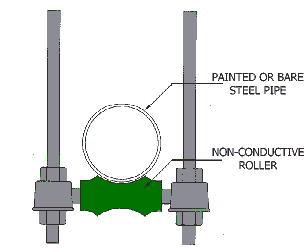
Non-Conductive Rollers should be used in lieu of, or as a direct replacement for, cast iron rolls on any bridge main installation that is, or is going to be, painted. This applies for both existing and new mains. Most paints provide only a thin barrier and are extremely susceptible to abrasion damage. This is particularly true at each pipe to support contact.
Reasons
The polyurethane based Non-Conductive Rollers are best used alone with thin coatings because they are non-abrasive and maintain a minimum surface contact. This eliminates any possibility of moisture collecting between pipe and support. In addition, the Non-Conductive Rollers are solid and do not have the same tendency to bind as the hollow cast iron rolls. Lubricating the roller’s stainless steel sleeve prior to inserting the axle seals out moisture and reduces friction.
When a pipe has a thin barrier coating the use of a FRP Shield increases the possibility of moisture entrapment between the pipe and shield interface. In most cases this would aggravate any corrosive conditions located between the pipe and FRP Shield.
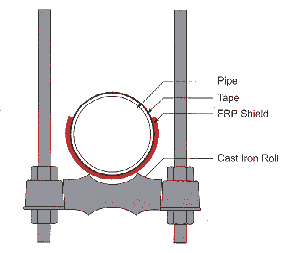
A FRP Type #240 Shield should be installed with any factory or field applied tape. This is particularly important when cast iron rolls are used. The profile of cast iron rolls do not accommodate thick barrier coatings. The tapes change the OD of the pipe to the point it will no longer rest in the cradle of the roll as is the case with bare or painted pipes. Instead, the pipe will rest on the peaks of the roll. This situation aggravates the point loading that normally occurs at each of the pipe’s supports.
Reasons
Tape wraps are thick barrier coating that must be protected at each support. Without protection the tape will cold flow as a result of being sandwiched between the pipe and its support. Abrasion due to even minor thermal expansion and contraction will further compromise the integrity of the tape. Fiberglass reinforcement enables the FRP Shields to tolerate the point loading and prevent abrasion damage by providing a desirable weight distribution. The FRP Shields also ensure a high degree of electrical isolation. Unlike non-reinforced plastics, the Fiberglass Reinforced Shields do not get brittle in the cold and are resistant to UV degradation.
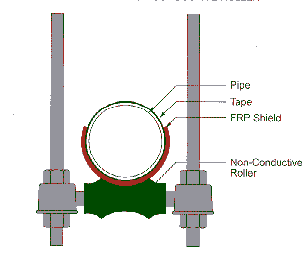
A FRP Type #240 Shield should be installed with any factory or field applied tape. This is the case even when Non-Conductive Rollers are used. The profile of a urethane roller is designed to accommodate both the tape wrap and FRP Shield. Although the Non-Conductive Rollers greatly reduce the possibility of abrasion, the tape must still be protected from cold flow damage. FRP Shields prevent damage by providing the necessary weight distribution between the pipe and its support. This is particularly important if the pipe becomes misaligned.
Reasons
When used together, the Non-Conductive Rollers and FRP Shields provide the best possible protection for any tape type wrap. Unlike hollow cast iron rolls, the Non-Conductive Rollers are solid and do not tend to bind and will not corrode internally. The urethane composition stays flexible even in cold temperatures. This provides a degree of vibration tolerance which one of the primary causes for alignment problems. Lubricating the roller’s stainless steel sleeve seals out moisture and reduces friction. FRP Shields maintain the tape’s integrity against both normal and possible abnormal loading due to misalignments and/or support failure.

1550 Cobb Industrial Dr. | P.O. Box 9098 | Marietta, GA 30065-2098
770-425-1355 (Phone) | 770-425-1354 (Fax) | info@alliedcorrosion.com (Email)
Made with ❤ by Mighty Good Marketing
We care about your privacy! In order to run a successful website, we are setting cookies and accessing and storing information on your device for various purposes. By continuing to browse this site, you are agreeing to our use of cookies.
If you wish to disable cookies, please visit our Privacy Policy for more information.
Got It! Thanks!Privacy policy